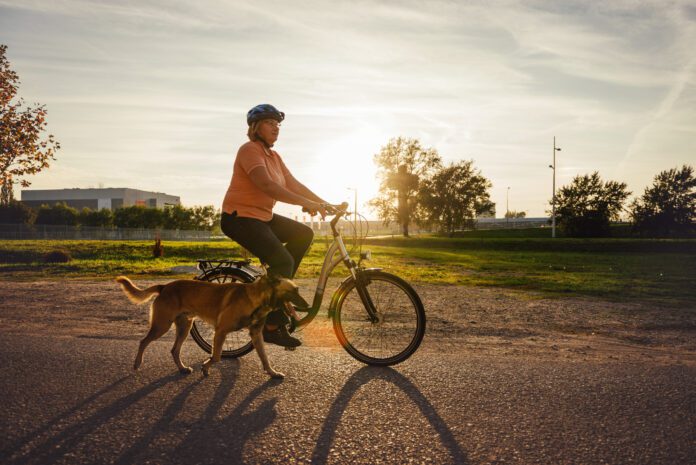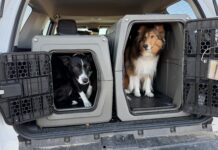Riding a bike with a running dog as a companion can be done safely. If you put in the time for training, invest in the proper equipment, and follow some safety rules, the activity can be fun and safe for you both.
Equipment for the cyclist
You’ll need some basic bicycling equipment:
- A bike that’s suitable for the terrain where you plan to ride (hybrid bikes are ideal for mainly paved roads, dirt roads, well-mowed fields, and smooth bike trails; mountain bikes are best dirt trails with rougher terrain)
- Well-fitting helmet
- A water bottle or two (your dog may need more water than you!)
- A spare tube or tire repair kit and a tire pump
- ID, money (or a credit card), and a cell phone

If you use a bike attachment to connect your dog to your bicycle, never walk away from your parked bike with your dog still attached to it. If your dog decides to follow you, or lunges after a passing squirrel, the bike will come crashing down. If you’re lucky, it won’t fall on your dog, but at the very least the crash will frighten him. Still attached, your dog will try to run away from the scary machine that crashed next to him. The bike then becomes a mechanical monster, chasing him as he tries to escape.
This could end your dog’s career as your riding partner, unless you are able to desensitize him once again to something that he is now terrified of. So to keep the “bike monster” at bay, always detach your dog from the bike when you step away.
Equipment for the dog
Your dog should be equipped with:
- ID tags that have your current contact information
- A reflective collar, harness, or vest
- A leash attachment for your bike
That last item is the most important. Riding a bike while holding a dog’s leash in your hand, or tied to the seat post or handlebars is highly unsafe. The dog can easily pull you off balance causing a crash, or you could collide with your dog if he runs in front of your front tire. If he lags behind, you may be pulled backward, possibly falling and sustaining an injury. Then there’s the possibility of the leash becoming entangled in the wheel spokes, perhaps resulting in serious injury to you both.
Fortunately, there are some devices on the market designed to facilitate a safer, more comfortable ride with your dog. These attachments allow you to keep both hands on your handlebars while keeping your dog at a safe distance from your bike.
Many users of these bike attachments are not only happy with the increased safety they provide, but also claim that their dogs stay focused on running beside the bike and attempt to pull less than when walking on leash.
Bike attachments for cycling with your dog install on either side of your bike. Which side your dog runs on is a matter of preference. If your dog is accustomed to walking or running on your left side, this may be the most natural position for training for bicycling. However, there are other considerations, especially if you ride on roads. As a pedestrian, you should walk or run against (facing) traffic. Having your dog on your left side when on foot keeps your dog safely away from passing cars. But moving vehicles, including bikes, are required by law to travel with traffic, on the right side of the road. Your dog is in a more vulnerable position running on the left side of your bike next to traffic.
All of the products below attach to a bicycle seat post. Each has a bar that holds either a spring-loaded paracord “leash” with a snap on it, or a flexible rubber-like leash section that snaps onto your dog’s collar or harness.
Dog Bike Leash Attachments
- Easy Ride V2.0 by Malabi, $75. This one swivels so that your dog can pass behind your bike to change sides.
- Sherpa Cycleash, $48. This one is not spring-loaded but uses a rubbery leash section.
- Walky Dog Plus Bicycle Exercise Leash, $66.
- Start out slow. Get your dog comfortable with a parked bike before walking him alongside a bike you are pushing. Only when he’s comfortable with these things should you actually mount up and ride – slowly!
- Always wear a helmet when cycling. If you need one more reason to convince you, consider this: If you fell and were knocked out, what would happen to your dog?
- Ride at a conservative pace, for short distances, until your dog builds fitness.
- If your dog’s enthusiasm or speed lags, stop and investigate. Offer him some water, and slow your pace on the way home.
Training Your Dog to Bike With You
To become a good cycling companion, a dog needs to go through a learning curve similar to the one you experienced as a child learning to ride your bike. Your dog should be comfortable around your bike, when you are both stationary and moving. He needs to be familiar with any equipment you use, and learn how to slow down, turn, and stop. And just as you started slowly on your first bike, the time and distance your dog accompanies you on bike rides should increase gradually.
Some dogs are fearful of moving bicycles, so you may need to help your dog become comfortable around your bike.
In your house or garage, start by holding your bike, calling your dog to you, and allowing him to sniff it. Praise him, pet him, and give him a yummy treat to reward his bravery. Lay your bike down, sit on the floor next to your bike, and repeat the exercise. You can even place treats on the tires, the frame, and the pedals, playing a game with your dog while he begins to associate this strange machine with having fun. Next, walk a few steps with your bike and encourage your dog to follow, using praise and treats. Continue to practice indoors, eventually adding your dog’s harness and leash, and moving outdoors only when your dog is comfortable walking alongside you and your bike.
- Outdoors, repeat the same walking exercise on leash. Move the bike so it wobbles, make some turns, walk faster then slower, even jog a little. If your dog shows any signs of apprehension, you have progressed too quickly. You may need to practice over several days before your dog will happily walk alongside you and your bike with distractions. When your dog handles these challenges with ease, teach him some cues for behaviors that you will use to guide him when you ride, such as “Slow,” “Stop,” “Easy,” “Turn,” and “Leave It.”
If you and your dog are just beginning to exercise regularly or more strenuously, physical exams by your respective doctors are advisable. Your veterinarian can offer safety precautions regarding age, breed, weight, and thickness of coat.
Check with your vet about when your young puppy’s growth plates are expected to close so you won’t risk injuring your puppy’s development by beginning a structured exercise program too soon. And as with all new forms of exercise, beginning slowly and building up duration and distance over time, no matter what condition you and your dog are in, is the safest way to go.
Starting to ride
Now that your dog walks happily next to you and your bike on-leash, it should be no problem to switch to the cord or leash of a bike attachment. Continue to practice walking with your dog attached to your bike, and if he shows no signs of uneasiness, get on your bike and pedal slowly. If you have gradually accustomed your dog to moving with your bike, he will likely be happy to trot alongside you. Take him for a slow, short excursion, using lots of encouragement, praise, and treats.
Future rides should increase slowly in time and distance, working up to a steady trot. After several rides together, you will begin to develop a feeling for your dog’s natural pace. Your dog may try to keep up until he drops, never showing signs of discomfort, no matter what speed you ride. It is important for you to let him set the pace. Use a comfortable trotting pace for the bulk of your rides.
The frequency, distance, and duration of your rides with your dog depend on many factors. Age, breed, size, fitness level, coat, running surface, and weather should be considered. Keep your dog well-hydrated, familiarize yourself with the symptoms of heatstroke (see “Heat Stroke in Dogs”), inspect his paw pads often, check for harness chafing, and watch for signs of lameness or waning enthusiasm. Increasing distance and duration slowly will help prevent soreness and injury, allowing your dog’s respiratory and musculoskeletal systems to adapt to increasing workloads.
Sometimes, the safety precautions that we take to protect both humans and our companion animals may seem so cumbersome that they take all the fun out of some of our activities. But when it comes to the health and welfare of your dog when accompanying you on bike rides, taking the appropriate safety measures can potentially save your dog’s life, as well as your own. Training, using proper equipment, and adhering to sensible exercise practices actually increase your enjoyment of the sport. “Fun” is knowing that you are keeping your dog as safe as possible while sharing your rides together. Enjoy!





